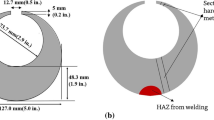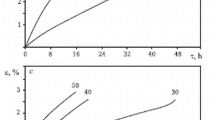Abstract
The effect of specimen and bath temperature on the failure of brittle ceramics in a thermal quench experiment was studied by quenching glass and alumina rods in water and silicon oil baths at different temperatures. The results were discussed in terms of the variation of heat transfer coefficient of the quenching media and the change in material properties as a function of temperature. It was found that the usual assumption of constant heat transfer coefficient and material properties may lead to considerable errors in the quantitative interpretation of the results of thermal quench experiments. Effective values for the film coefficient of heat transfer for water and oil baths were estimated as a function of film temperature from thermal quench data. Recommendations were made for the selection of quenching media and for the procedure to be followed in reporting the results.
Similar content being viewed by others
References
B. A. Boley and J. H. Weiner, “Theory of Thermal Stresses” (Wiley and Sons, New York, 1960).
D. P. H. Hasselman, J. Amer. Ceram. Soc. 52 (1969) 600.
W. D. Kingery, ibid. 38 (1955) 3.
D. P. H. Hasselman, Ceramurgia 4 (1979) 147.
J. P. Singh, J. R. Thomas, Jr and D. P. H. Hasselman, J. Amer. Ceram. Soc. 63 (1980) 140.
D. P. H. Hasselman, J. R. Thomas, Jr, M. P. Kamat and K. Satyamurthy, ibid. 63 (1980) 21.
R. W. Davidge and G. Tappin, Trans. Brit. Ceram. Soc. 66 (1967) 405.
D. P. H. Hasselman, J. Amer. Ceram. Soc. 53 (1970) 490.
E. Glenny and M. G. Royston, Trans. Brit. Ceram. Soc. 57 (1958) 645.
K. Anzai and H. Hashimoto, J. Mater. Sci. 12 (1977) 235.
R. Badaliance, D. A. Krohn and D. P. H. Hasselman, J. Amer. Ceram. Soc. 57 (1974) 432.
W. Weibull, J. Appl. Mech. 18 (1951) 293.
D. P. H. Hasselman, R. Badaliance, K. R. McKinney and C. H. Kim, J. Mater. Sci, 11 (1976) 458.
J. C. Jaeger, Philos. Mag. 36 (1945) 418.
S. S. Manson and R. W. Smith, Trans. ASME 78 (1956) 533.
K. Satyamurthy, J. P. Singh, D. P. H. Hasselman and M. P. Kamat, J. Amer. Chem. Soc. 63 (1980) 694.
F. Kreith, “Principles of Heat Transfer,” (Intext Educational Publishers, New York, 1973).
E. B. Shand, “Glass Engineering Handbook” (McGraw-Hill Book Co., New York, 1958).
P. F. Becher, D. Lewis III, K. R. Carman and A. C. Gonzalez, J. Amer. Ceram. Soc. 59 (1980) 542.
Author information
Authors and Affiliations
Rights and permissions
About this article
Cite this article
Singh, J.P., Tree, Y. & Hasselman, D.P.H. Effect of bath and specimen temperature on the thermal stress resistance of brittle ceramics subjected to thermal quenching. J Mater Sci 16, 2109–2118 (1981). https://doi.org/10.1007/BF00542371
Received:
Accepted:
Issue Date:
DOI: https://doi.org/10.1007/BF00542371




